LINCOLN MKT 2018 Owner's Guide
Manufacturer: LINCOLN, Model Year: 2018, Model line: MKT, Model: LINCOLN MKT 2018Pages: 564, PDF Size: 4.66 MB
Page 31 of 564
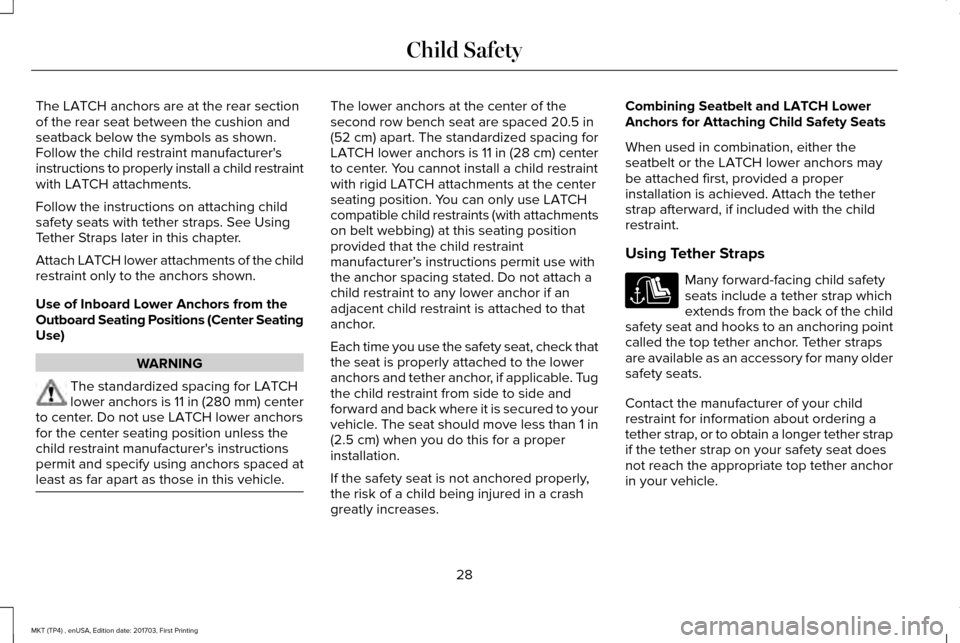
The LATCH anchors are at the rear section
of the rear seat between the cushion and
seatback below the symbols as shown.
Follow the child restraint manufacturer's
instructions to properly install a child restraint
with LATCH attachments.
Follow the instructions on attaching child
safety seats with tether straps. See Using
Tether Straps later in this chapter.
Attach LATCH lower attachments of the child
restraint only to the anchors shown.
Use of Inboard Lower Anchors from the
Outboard Seating Positions (Center Seating
Use)
WARNING
The standardized spacing for LATCH
lower anchors is 11 in (280 mm) center
to center. Do not use LATCH lower anchors
for the center seating position unless the
child restraint manufacturer's instructions
permit and specify using anchors spaced at
least as far apart as those in this vehicle. The lower anchors at the center of the
second row bench seat are spaced 20.5 in
(52 cm) apart. The standardized spacing for
LATCH lower anchors is 11 in (28 cm) center
to center. You cannot install a child restraint
with rigid LATCH attachments at the center
seating position. You can only use LATCH
compatible child restraints (with attachments
on belt webbing) at this seating position
provided that the child restraint
manufacturer’ s instructions permit use with
the anchor spacing stated. Do not attach a
child restraint to any lower anchor if an
adjacent child restraint is attached to that
anchor.
Each time you use the safety seat, check that
the seat is properly attached to the lower
anchors and tether anchor, if applicable. Tug
the child restraint from side to side and
forward and back where it is secured to your
vehicle. The seat should move less than 1 in
(2.5 cm)
when you do this for a proper
installation.
If the safety seat is not anchored properly,
the risk of a child being injured in a crash
greatly increases. Combining Seatbelt and LATCH Lower
Anchors for Attaching Child Safety Seats
When used in combination, either the
seatbelt or the LATCH lower anchors may
be attached first, provided a proper
installation is achieved. Attach the tether
strap afterward, if included with the child
restraint.
Using Tether Straps
Many forward-facing child safety
seats include a tether strap which
extends from the back of the child
safety seat and hooks to an anchoring point
called the top tether anchor. Tether straps
are available as an accessory for many older
safety seats.
Contact the manufacturer of your child
restraint for information about ordering a
tether strap, or to obtain a longer tether strap
if the tether strap on your safety seat does
not reach the appropriate top tether anchor
in your vehicle.
28
MKT (TP4) , enUSA, Edition date: 201703, First Printing Child Safety
Page 32 of 564
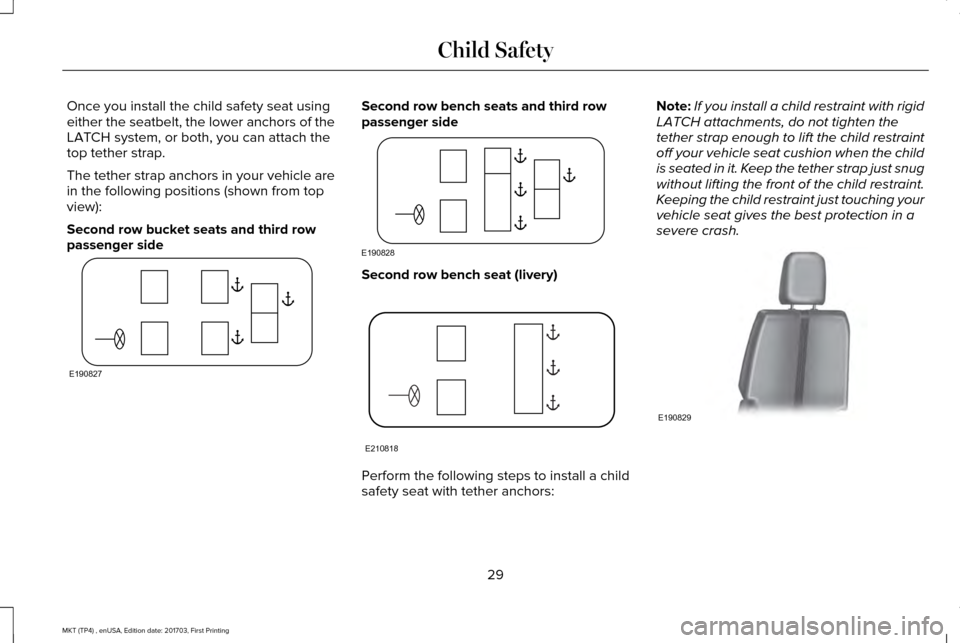
Once you install the child safety seat using
either the seatbelt, the lower anchors of the
LATCH system, or both, you can attach the
top tether strap.
The tether strap anchors in your vehicle are
in the following positions (shown from top
view):
Second row bucket seats and third row
passenger side Second row bench seats and third row
passenger side
Second row bench seat (livery)
Perform the following steps to install a child
safety seat with tether anchors:Note:
If you install a child restraint with rigid
LATCH attachments, do not tighten the
tether strap enough to lift the child restraint
off your vehicle seat cushion when the child
is seated in it. Keep the tether strap just snug
without lifting the front of the child restraint.
Keeping the child restraint just touching your
vehicle seat gives the best protection in a
severe crash. 29
MKT (TP4) , enUSA, Edition date: 201703, First Printing Child SafetyE190827 E190828 E210818 E190829
Page 33 of 564
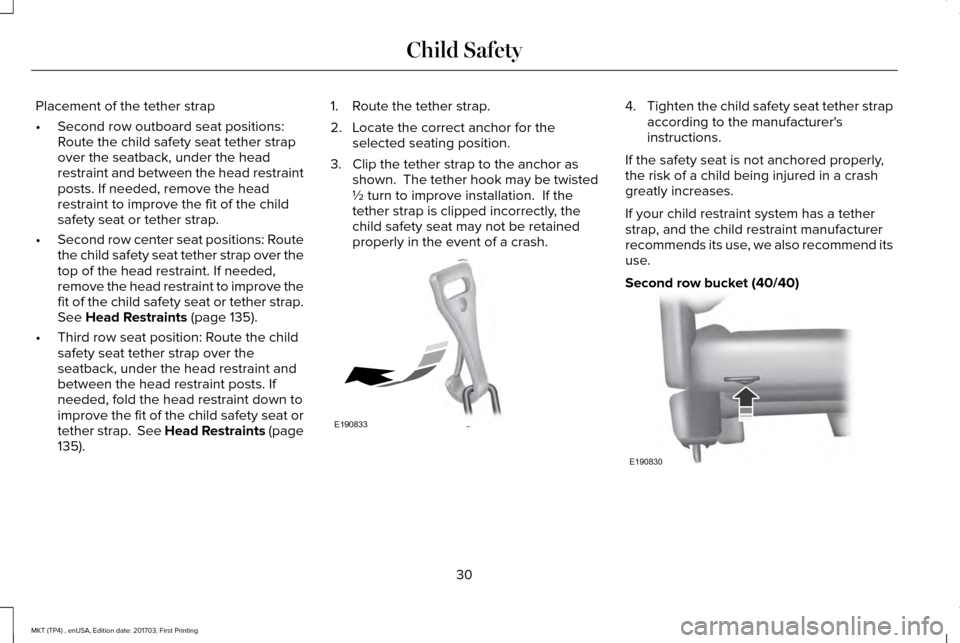
Placement of the tether strap
•
Second row outboard seat positions:
Route the child safety seat tether strap
over the seatback, under the head
restraint and between the head restraint
posts. If needed, remove the head
restraint to improve the fit of the child
safety seat or tether strap.
• Second row center seat positions: Route
the child safety seat tether strap over the
top of the head restraint. If needed,
remove the head restraint to improve the
fit of the child safety seat or tether strap.
See Head Restraints (page 135).
• Third row seat position: Route the child
safety seat tether strap over the
seatback, under the head restraint and
between the head restraint posts. If
needed, fold the head restraint down to
improve the fit of the child safety seat or
tether strap. See Head Restraints (page
135
). 1. Route the tether strap.
2. Locate the correct anchor for the
selected seating position.
3. Clip the tether strap to the anchor as shown. The tether hook may be twisted
½ turn to improve installation. If the
tether strap is clipped incorrectly, the
child safety seat may not be retained
properly in the event of a crash. 4.
Tighten the child safety seat tether strap
according to the manufacturer's
instructions.
If the safety seat is not anchored properly,
the risk of a child being injured in a crash
greatly increases.
If your child restraint system has a tether
strap, and the child restraint manufacturer
recommends its use, we also recommend its
use.
Second row bucket (40/40) 30
MKT (TP4) , enUSA, Edition date: 201703, First Printing Child SafetyE190833 E190830
Page 34 of 564
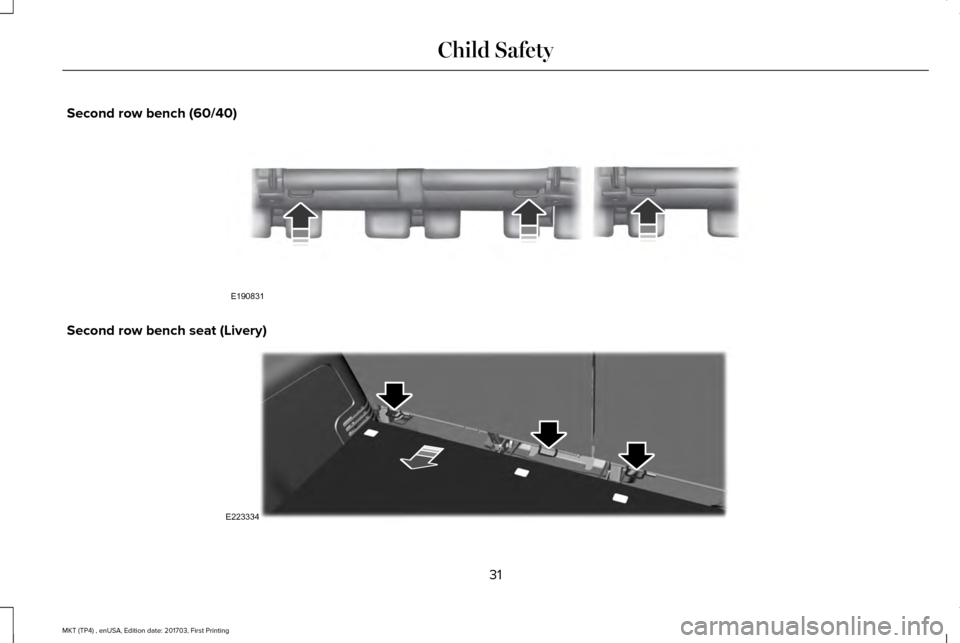
Second row bench (60/40)
Second row bench seat (Livery)
31
MKT (TP4) , enUSA, Edition date: 201703, First Printing Child SafetyE190831 E223334
Page 35 of 564
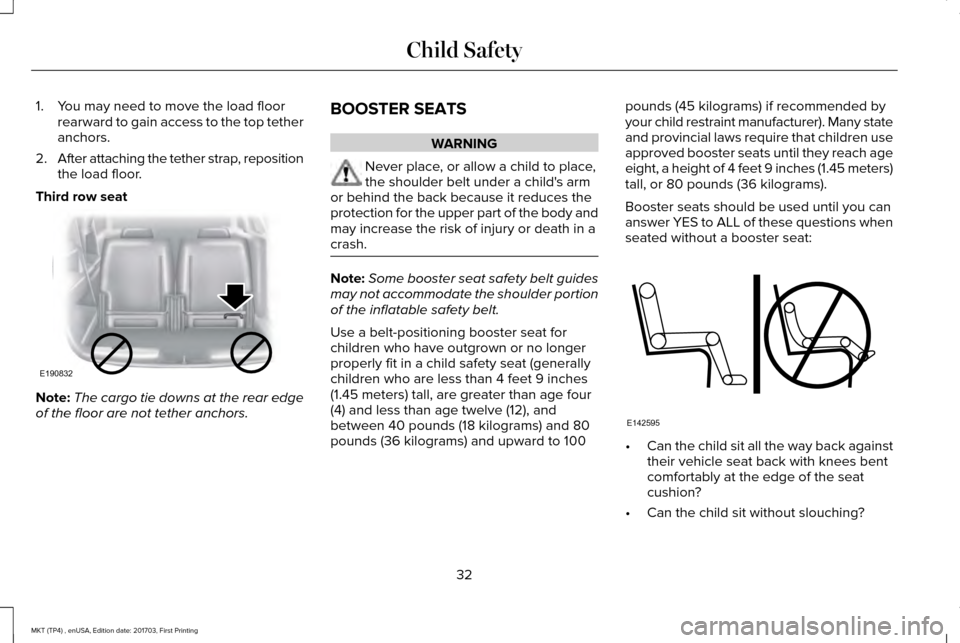
1. You may need to move the load floor
rearward to gain access to the top tether
anchors.
2. After attaching the tether strap, reposition
the load floor.
Third row seat Note:
The cargo tie downs at the rear edge
of the floor are not tether anchors. BOOSTER SEATS WARNING
Never place, or allow a child to place,
the shoulder belt under a child's arm
or behind the back because it reduces the
protection for the upper part of the body and
may increase the risk of injury or death in a
crash. Note:
Some booster seat safety belt guides
may not accommodate the shoulder portion
of the inflatable safety belt.
Use a belt-positioning booster seat for
children who have outgrown or no longer
properly fit in a child safety seat (generally
children who are less than 4 feet 9 inches
(1.45 meters) tall, are greater than age four
(4) and less than age twelve (12), and
between 40 pounds (18 kilograms) and 80
pounds (36 kilograms) and upward to 100 pounds (45 kilograms) if recommended by
your child restraint manufacturer). Many state
and provincial laws require that children use
approved booster seats until they reach age
eight, a height of 4 feet 9 inches (1.45 meters)
tall, or 80 pounds (36 kilograms).
Booster seats should be used until you can
answer YES to ALL of these questions when
seated without a booster seat:
•
Can the child sit all the way back against
their vehicle seat back with knees bent
comfortably at the edge of the seat
cushion?
• Can the child sit without slouching?
32
MKT (TP4) , enUSA, Edition date: 201703, First Printing Child SafetyE190832 E142595
Page 36 of 564
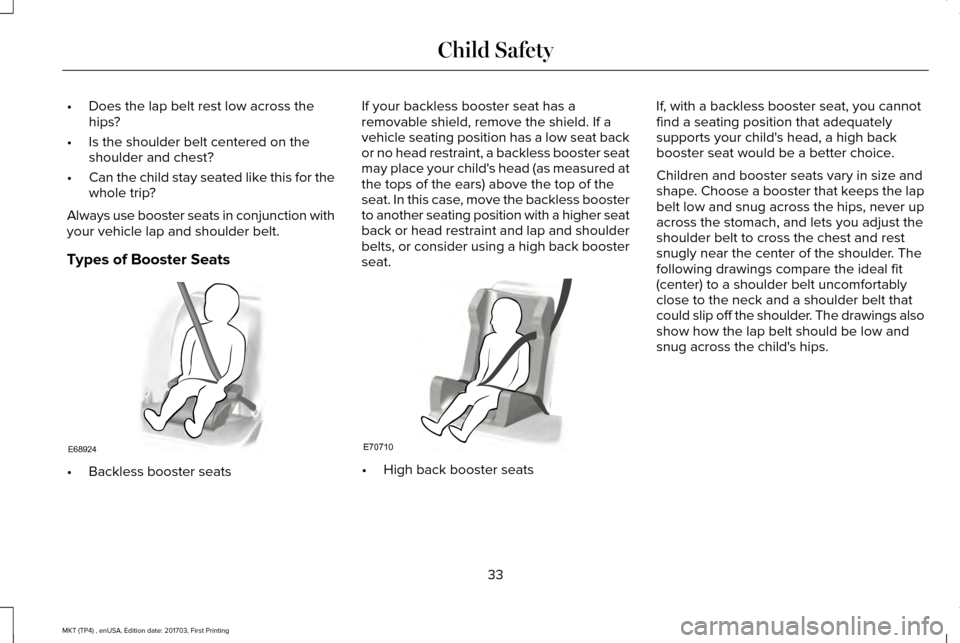
•
Does the lap belt rest low across the
hips?
• Is the shoulder belt centered on the
shoulder and chest?
• Can the child stay seated like this for the
whole trip?
Always use booster seats in conjunction with
your vehicle lap and shoulder belt.
Types of Booster Seats •
Backless booster seats If your backless booster seat has a
removable shield, remove the shield. If a
vehicle seating position has a low seat back
or no head restraint, a backless booster seat
may place your child's head (as measured at
the tops of the ears) above the top of the
seat. In this case, move the backless booster
to another seating position with a higher seat
back or head restraint and lap and shoulder
belts, or consider using a high back booster
seat.
•
High back booster seats If, with a backless booster seat, you cannot
find a seating position that adequately
supports your child's head, a high back
booster seat would be a better choice.
Children and booster seats vary in size and
shape. Choose a booster that keeps the lap
belt low and snug across the hips, never up
across the stomach, and lets you adjust the
shoulder belt to cross the chest and rest
snugly near the center of the shoulder. The
following drawings compare the ideal fit
(center) to a shoulder belt uncomfortably
close to the neck and a shoulder belt that
could slip off the shoulder. The drawings also
show how the lap belt should be low and
snug across the child's hips.
33
MKT (TP4) , enUSA, Edition date: 201703, First Printing Child SafetyE68924 E70710
Page 37 of 564
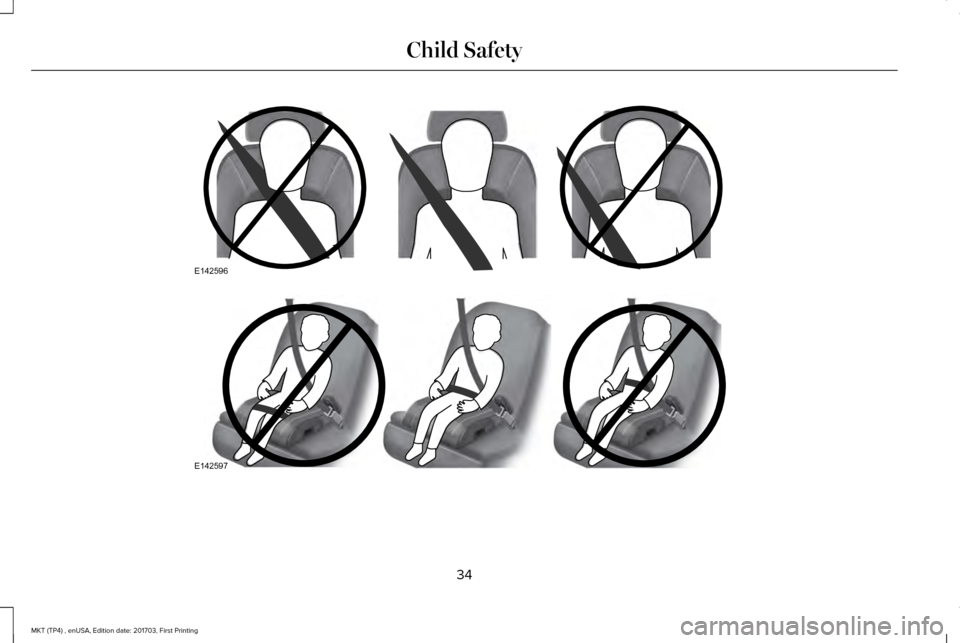
34
MKT (TP4) , enUSA, Edition date: 201703, First Printing Child SafetyE142596 E142597
Page 38 of 564
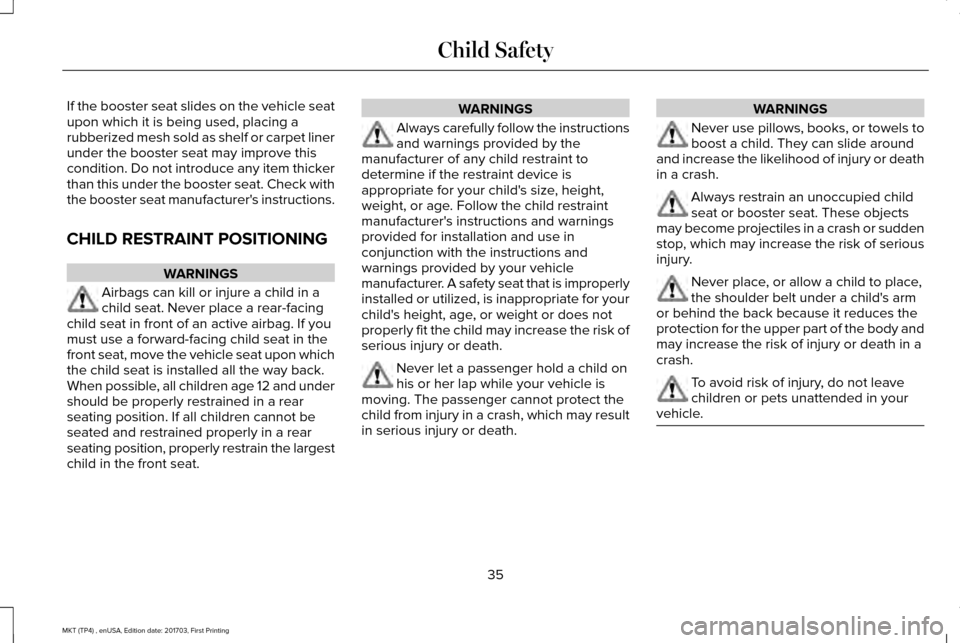
If the booster seat slides on the vehicle seat
upon which it is being used, placing a
rubberized mesh sold as shelf or carpet liner
under the booster seat may improve this
condition. Do not introduce any item thicker
than this under the booster seat. Check with
the booster seat manufacturer's instructions.
CHILD RESTRAINT POSITIONING
WARNINGS
Airbags can kill or injure a child in a
child seat. Never place a rear-facing
child seat in front of an active airbag. If you
must use a forward-facing child seat in the
front seat, move the vehicle seat upon which
the child seat is installed all the way back.
When possible, all children age 12 and under
should be properly restrained in a rear
seating position. If all children cannot be
seated and restrained properly in a rear
seating position, properly restrain the largest
child in the front seat. WARNINGS
Always carefully follow the instructions
and warnings provided by the
manufacturer of any child restraint to
determine if the restraint device is
appropriate for your child's size, height,
weight, or age. Follow the child restraint
manufacturer's instructions and warnings
provided for installation and use in
conjunction with the instructions and
warnings provided by your vehicle
manufacturer. A safety seat that is improperly
installed or utilized, is inappropriate for your
child's height, age, or weight or does not
properly fit the child may increase the risk of
serious injury or death. Never let a passenger hold a child on
his or her lap while your vehicle is
moving. The passenger cannot protect the
child from injury in a crash, which may result
in serious injury or death. WARNINGS
Never use pillows, books, or towels to
boost a child. They can slide around
and increase the likelihood of injury or death
in a crash. Always restrain an unoccupied child
seat or booster seat. These objects
may become projectiles in a crash or sudden
stop, which may increase the risk of serious
injury. Never place, or allow a child to place,
the shoulder belt under a child's arm
or behind the back because it reduces the
protection for the upper part of the body and
may increase the risk of injury or death in a
crash. To avoid risk of injury, do not leave
children or pets unattended in your
vehicle. 35
MKT (TP4) , enUSA, Edition date: 201703, First Printing Child Safety
Page 39 of 564
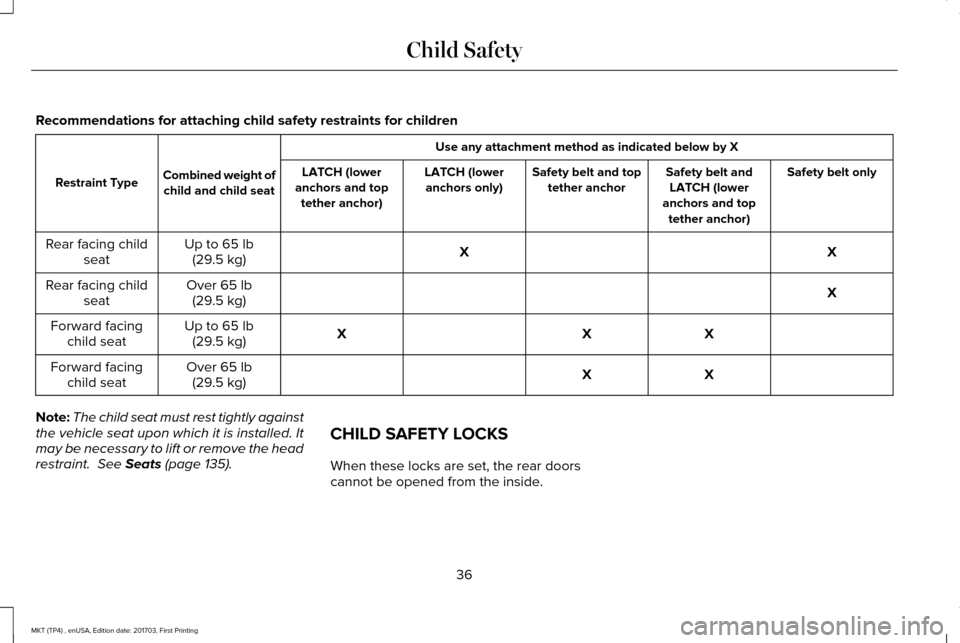
Recommendations for attaching child safety restraints for children
Use any attachment method as indicated below by X
Combined weight of child and child seat
Restraint Type Safety belt only
Safety belt and
LATCH (lower
anchors and top tether anchor)
Safety belt and top
tether anchor
LATCH (lower
anchors only)
LATCH (lower
anchors and top tether anchor)
X
X
Up to 65 lb
(29.5 kg)
Rear facing child
seat
X
Over
65 lb
(29.5 kg)
Rear facing child
seat
X
X
X
Up to
65 lb
(29.5 kg)
Forward facing
child seat
X
X
Over
65 lb
(29.5 kg)
Forward facing
child seat
Note: The child seat must rest tightly against
the vehicle seat upon which it is installed. It
may be necessary to lift or remove the head
restraint.
See Seats (page 135). CHILD SAFETY LOCKS
When these locks are set, the rear doors
cannot be opened from the inside.
36
MKT (TP4) , enUSA, Edition date: 201703, First Printing Child Safety
Page 40 of 564
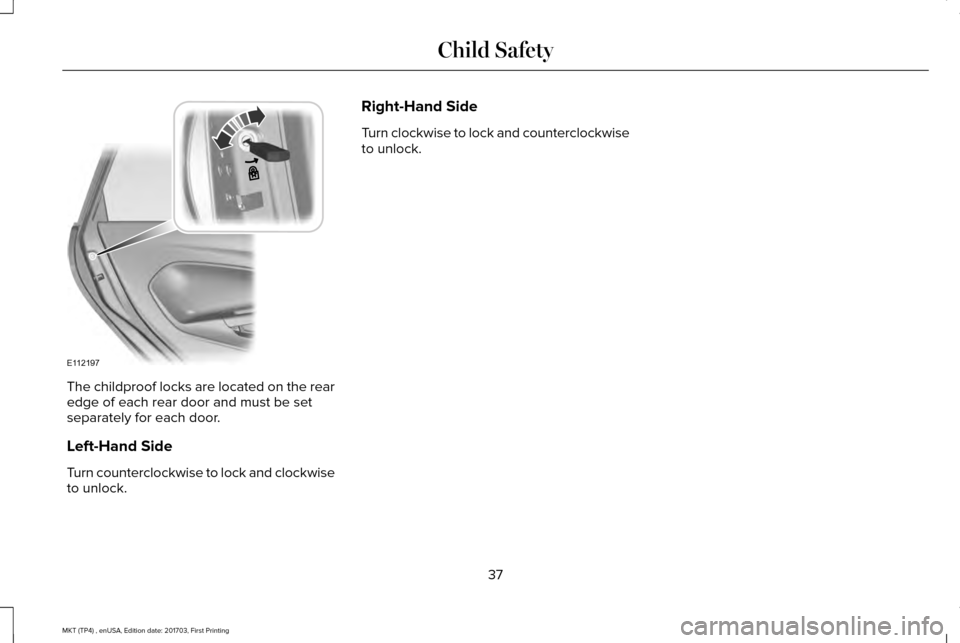
The childproof locks are located on the rear
edge of each rear door and must be set
separately for each door.
Left-Hand Side
Turn counterclockwise to lock and clockwise
to unlock. Right-Hand Side
Turn clockwise to lock and counterclockwise
to unlock.
37
MKT (TP4) , enUSA, Edition date: 201703, First Printing Child SafetyE112197